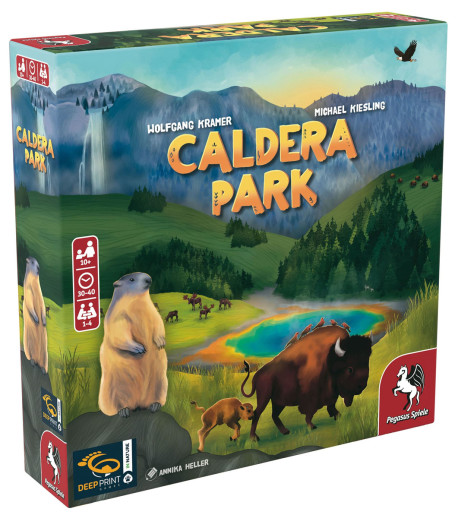We use cookies to make your experience better. To comply with the new e-Privacy directive, we need to ask for your consent to set the cookies. Learn more.
Caldera Park Game
- Small parts. Not for children under 3 years.
Visit the North American wilderness where Eagles nest and soar through mountain skies, Bison roam the prairie and visit waterfalls and rivers. There might be sunny days, but hailstorms and snowstorms may occur as well. Welcome to Caldera Park – a tile laying game where you can plan a park of your own, populate seven different terrain types with six animal types and plan their placement around weather forecasts to earn the most possible points to win the game!
Game Overview:
There are five rounds in this game with each consisting of the following three stages:
- Weather Forecast: Each player starts with a display of six different weather conditions that affect which groups and types of animals gain or lose points if specific tile patterns surround them. Players choose one and place it on their board at the beginning of the game, between each round and at the end of the game.
- Action Turns: There are seven turns that consist of three steps each.
- On the main board: The first player chooses one of six animal tokens or the watering hole tile. If choosing the watering hole, it is placed on the “all terrain” space. Otherwise, the eagle, elk, bison, goat, bear, or wolf are placed on the Mountains, Forests, Prairie, or beside a Geyser, River, or Waterfall space. The one chosen indicates which terrain type or location all players must place that animal type that turn.
- Each player chooses a tile from a display above his or her individual player boards. These tiles consist of single or groups of two or three of the same or different animal family and may contain a watering hole in place of an animal in a group. They all place this tile on their player board strategically choosing its location to maximize end-game point scoring variables while avoiding placing tiles next to bad weather icons they placed at the beginning of the round that indicate possible loss of points. One example of bad weather would be a hailstorm, which specifies that no points are earned for an animal tile placed next to it that contains a bear and/or at least one wolf and/or a watering hole. A thunderstorm might deduct points for a single, two or group of three animals on a tile depending on the number of thunderstorm clouds on the tile.
- Each player refills their animal token display to replace the tile they chose this turn. There should be seven tiles in the display. The first player token passes to the next player, and the next of the seven action turns begins with step A as above.
- End of Round: At the end of the seventh action turn – when all the animal tokens are placed on terrain spaces on the main board, all tokens on the main board are returned to the selection row. Play continues until the fifth-round ends after which end game scoring begins.
Scoring: All players check their animal park boards for animals affected by bad weather, and they flip those tokens over, so they are not included in scoring. Then, there are twelve different scoring criteria consisting of tile coverage of specific terrain tile types or consecutive groups of animal species tiles with watering holes contained in each species serving as multipliers. Only the largest of each type of animal family earns scoring points. The person with the most points wins!
In Caldera Park, I like the challenge of the randomly chosen weather tokens, which can cause players to re-think their strategy for tile selections. The rotating animal/terrain match up for each action turn where other players make the selection adds to the variety and interest of each turn. Caldera Park is a beautifully implemented game, and I find myself enthused to return to another play! There is a solo challenge and an alternate player board map with variable play instructions included. For 1-4 players with a 30 to 40-minute game time. ~ Marsha
Players run a national park and want to unite its animals in the largest families possible. Make sure that they find watering holes and that they completely fill many types of terrain. But beware, unpredictable weather can drive animals away, and the other players run their own parks and have a say in where certain species must go. Place your animals cleverly, carefully considering terrain and weather, and the best national park can be yours.
Number of players: For 1 to 4 player 8 years and older Playing time: 20 to 40 minutes
| Product Format: | Other |
|---|---|
| Brand: | Pegasus Spiele |
| Grades: | 4-AD |
| EAN/UPC: | 4250231734588 |
| Length in Inches: | 11.625 |
| Width in Inches: | 11.625 |
| Height in Inches: | 2.875 |
| Weight in Pounds: | 3.55 |

